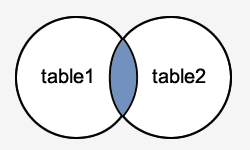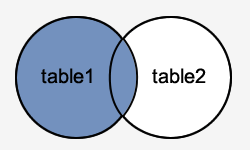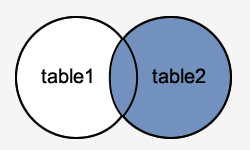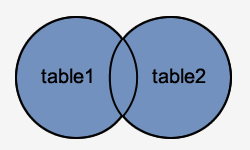How To Use Join In Sql

SQL: JOINS
This SQL tutorial explains how to utilise SQL JOINS with syntax, visual illustrations, and examples.
Description
SQL JOINS are used to recall data from multiple tables. A SQL Join is performed whenever two or more tables are listed in a SQL statement.
In that location are iv different types of SQL joins:
- SQL INNER Join (sometimes called uncomplicated join)
- SQL LEFT OUTER Join (sometimes chosen LEFT JOIN)
- SQL RIGHT OUTER JOIN (sometimes chosen RIGHT Join)
- SQL FULL OUTER JOIN (sometimes called FULL JOIN)
Then allow'southward discuss SQL JOIN syntax, look at visual illustrations of SQL JOINS and explore some examples.
DDL/DML for Examples
If you desire to follow along with this tutorial, get the DDL to create the tables and the DML to populate the data. And so endeavor the examples in your ain database!
Get DDL/DML
SQL INNER JOIN (simple join)
Chances are, you've already written a SQL statement that uses an SQL INNER JOIN. It is the most mutual type of SQL bring together. SQL INNER JOINS return all rows from multiple tables where the join condition is met.
Syntax
The syntax for the INNER Bring together in SQL is:
SELECT columns FROM table1 INNER JOIN table2 ON table1.cavalcade = table2.column;
Visual Illustration
In this visual diagram, the SQL INNER Bring together returns the shaded area:

The SQL INNER Join would return the records where table1 and table2 intersect.
Example
Let's look at an example of how to use the INNER JOIN in a query.
In this example, nosotros have a tabular array called customers with the following data:
| customer_id | last_name | first_name | favorite_website |
|---|---|---|---|
| 4000 | Jackson | Joe | techonthenet.com |
| 5000 | Smith | Jane | digminecraft.com |
| 6000 | Ferguson | Samantha | bigactivities.com |
| 7000 | Reynolds | Allen | checkyourmath.com |
| 8000 | Anderson | Paige | Nada |
| 9000 | Johnson | Derek | techonthenet.com |
And a table chosen orders with the following information:
| order_id | customer_id | order_date |
|---|---|---|
| one | 7000 | 2016/04/18 |
| two | 5000 | 2016/04/18 |
| three | 8000 | 2016/04/19 |
| 4 | 4000 | 2016/04/xx |
| 5 | Zip | 2016/05/01 |
Enter the following SQL statement:
Try It
SELECT customers.customer_id, orders.order_id, orders.order_date FROM customers INNER Bring together orders ON customers.customer_id = orders.customer_id ORDER By customers.customer_id;
There will be 4 records selected. These are the results that you should run into:
| customer_id | order_id | order_date |
|---|---|---|
| 4000 | 4 | 2016/04/20 |
| 5000 | two | 2016/04/18 |
| 7000 | ane | 2016/04/18 |
| 8000 | iii | 2016/04/nineteen |
This example would return all rows from the customers and orders tables where there is a matching customer_id value in both the customers and orders tables.
The rows where customer_id is equal to 6000 and 9000 in the customers table would be omitted, since they do non exist in both tables. The row where the order_id is v from the orders table would exist omitted, since the customer_id of NULL does non exist in the customers table.
Old Syntax
As a final note, it is worth mentioning that the INNER Join instance above could be rewritten using the older implicit syntax as follows (but we still recommend using the INNER JOIN keyword syntax):
Try It
SELECT customers.customer_id, orders.order_id, orders.order_date FROM customers, orders WHERE customers.customer_id = orders.customer_id Order By customers.customer_id;
SQL LEFT OUTER Join
Another type of join is called a LEFT OUTER JOIN. This type of bring together returns all rows from the LEFT-hand table specified in the ON condition and only those rows from the other tabular array where the joined fields are equal (join condition is met).
Syntax
The syntax for the LEFT OUTER JOIN in SQL is:
SELECT columns FROM table1 LEFT [OUTER] JOIN table2 ON table1.cavalcade = table2.column;
In some databases, the OUTER keyword is omitted and written simply every bit LEFT Bring together.
Visual Illustration
In this visual diagram, the SQL LEFT OUTER Bring together returns the shaded area:

The SQL LEFT OUTER JOIN would return the all records from table1 and only those records from table2 that intersect with table1.
Example
Now permit's look at an case that shows how to apply the LEFT OUTER Bring together in a SELECT statement.
Using the same customers tabular array as the previous instance:
| customer_id | last_name | first_name | favorite_website |
|---|---|---|---|
| 4000 | Jackson | Joe | techonthenet.com |
| 5000 | Smith | Jane | digminecraft.com |
| 6000 | Ferguson | Samantha | bigactivities.com |
| 7000 | Reynolds | Allen | checkyourmath.com |
| 8000 | Anderson | Paige | NULL |
| 9000 | Johnson | Derek | techonthenet.com |
And the orders tabular array with the post-obit data:
| order_id | customer_id | order_date |
|---|---|---|
| one | 7000 | 2016/04/xviii |
| 2 | 5000 | 2016/04/18 |
| iii | 8000 | 2016/04/nineteen |
| 4 | 4000 | 2016/04/xx |
| 5 | NULL | 2016/05/01 |
Enter the following SQL statement:
Effort It
SELECT customers.customer_id, orders.order_id, orders.order_date FROM customers LEFT OUTER Bring together orders ON customers.customer_id = orders.customer_id Social club Past customers.customer_id;
At that place will be 6 records selected. These are the results that you should run across:
| customer_id | order_id | order_date |
|---|---|---|
| 4000 | 4 | 2016/04/20 |
| 5000 | two | 2016/04/18 |
| 6000 | Zippo | NULL |
| 7000 | 1 | 2016/04/18 |
| 8000 | iii | 2016/04/xix |
| 9000 | Cypher | NULL |
This LEFT OUTER JOIN example would return all rows from the customers table and only those rows from the orders tabular array where the joined fields are equal.
If a customer_id value in the customers table does non exist in the orders table, all fields in the orders table will display as NULL in the outcome gear up. Every bit you tin can see, the rows where customer_id is 6000 and 9000 would be included with a LEFT OUTER Bring together simply the order_id and order_date fields display NULL.
SQL Correct OUTER Join
Another type of bring together is called a SQL Correct OUTER JOIN. This type of bring together returns all rows from the Correct-manus table specified in the ON status and simply those rows from the other tabular array where the joined fields are equal (join status is met).
Syntax
The syntax for the RIGHT OUTER Join in SQL is:
SELECT columns FROM table1 RIGHT [OUTER] Bring together table2 ON table1.column = table2.column;
In some databases, the OUTER keyword is omitted and written simply as RIGHT Bring together.
Visual Illustration
In this visual diagram, the SQL RIGHT OUTER Bring together returns the shaded area:

The SQL RIGHT OUTER JOIN would render the all records from table2 and just those records from table1 that intersect with table2.
Case
At present let'south await at an case that shows how to use the Correct OUTER JOIN in a SELECT argument.
Using the same customers table as the previous example:
| customer_id | last_name | first_name | favorite_website |
|---|---|---|---|
| 4000 | Jackson | Joe | techonthenet.com |
| 5000 | Smith | Jane | digminecraft.com |
| 6000 | Ferguson | Samantha | bigactivities.com |
| 7000 | Reynolds | Allen | checkyourmath.com |
| 8000 | Anderson | Paige | NULL |
| 9000 | Johnson | Derek | techonthenet.com |
And the orders table with the post-obit information:
| order_id | customer_id | order_date |
|---|---|---|
| 1 | 7000 | 2016/04/eighteen |
| 2 | 5000 | 2016/04/18 |
| 3 | 8000 | 2016/04/nineteen |
| iv | 4000 | 2016/04/xx |
| 5 | NULL | 2016/05/01 |
Enter the post-obit SQL argument:
Try It
SELECT customers.customer_id, orders.order_id, orders.order_date FROM customers RIGHT OUTER JOIN orders ON customers.customer_id = orders.customer_id Lodge BY customers.customer_id;
In that location will be 5 records selected. These are the results that you should run across:
| customer_id | order_id | order_date |
|---|---|---|
| NULL | 5 | 2016/05/01 |
| 4000 | 4 | 2016/04/xx |
| 5000 | two | 2016/04/18 |
| 7000 | i | 2016/04/xviii |
| 8000 | 3 | 2016/04/19 |
This Right OUTER Bring together example would return all rows from the orders table and only those rows from the customers table where the joined fields are equal.
If a customer_id value in the orders tabular array does not exist in the customers tabular array, all fields in the customers tabular array will display as Naught in the result set. As you tin run into, the row where order_id is 5 would be included with a RIGHT OUTER Bring together but the customer_id field displays NULL.
SQL FULL OUTER Join
Another blazon of join is called a SQL Full OUTER JOIN. This type of join returns all rows from the LEFT-hand table and RIGHT-hand table with Nix values in place where the join condition is not met.
Syntax
The syntax for the SQL Full OUTER JOIN is:
SELECT columns FROM table1 FULL [OUTER] Bring together table2 ON table1.cavalcade = table2.cavalcade;
In some databases, the OUTER keyword is omitted and written just every bit Full Join.
Visual Illustration
In this visual diagram, the SQL Total OUTER JOIN returns the shaded expanse:

The SQL Full OUTER Bring together would render the all records from both table1 and table2.
Example
Let's wait at an example that shows how to utilise the Total OUTER Join in a SELECT statement.
Using the same customers table every bit the previous example:
| customer_id | last_name | first_name | favorite_website |
|---|---|---|---|
| 4000 | Jackson | Joe | techonthenet.com |
| 5000 | Smith | Jane | digminecraft.com |
| 6000 | Ferguson | Samantha | bigactivities.com |
| 7000 | Reynolds | Allen | checkyourmath.com |
| 8000 | Anderson | Paige | Naught |
| 9000 | Johnson | Derek | techonthenet.com |
And the orders table with the following data:
| order_id | customer_id | order_date |
|---|---|---|
| 1 | 7000 | 2016/04/xviii |
| two | 5000 | 2016/04/eighteen |
| 3 | 8000 | 2016/04/xix |
| 4 | 4000 | 2016/04/20 |
| 5 | Aught | 2016/05/01 |
Enter the following SQL statement:
Try It
SELECT customers.customer_id, orders.order_id, orders.order_date FROM customers Full OUTER JOIN orders ON customers.customer_id = orders.customer_id Gild BY customers.customer_id;
In that location will exist vii records selected. These are the results that you should meet:
| customer_id | order_id | order_date |
|---|---|---|
| NULL | 5 | 2016/05/01 |
| 4000 | 4 | 2016/04/20 |
| 5000 | two | 2016/04/eighteen |
| 6000 | Cipher | NULL |
| 7000 | i | 2016/04/18 |
| 8000 | iii | 2016/04/nineteen |
| 9000 | NULL | Nix |
This FULL OUTER JOIN instance would return all rows from the orders table and all rows from the customers tabular array. Whenever the joined condition is not met, a NULL value would be extended to those fields in the result gear up. This means that if a customer_id value in the customers table does non exist in the orders table, all fields in the orders table will display as NULL in the consequence set. Also, if a customer_id value in the orders table does not exist in the customers table, all fields in the customers table will display as Nil in the outcome gear up.
Every bit you can come across, the rows where the customer_id is 6000 and 9000 would be included only the order_id and order_date fields for those records contains a NULL value. The row where the order_id is 5 would exist also included but the customer_id field for that tape has a Cypher value.
How To Use Join In Sql,
Source: https://www.techonthenet.com/sql/joins.php
Posted by: ablerithey.blogspot.com


0 Response to "How To Use Join In Sql"
Post a Comment